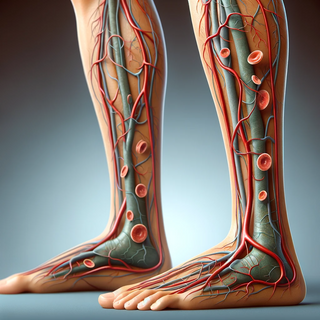Have you ever noticed your legs feeling tired and heavy after a short walk? Maybe your feet get tingly or cool to the touch, even when it's not cold. These could be signs of a hidden problem affecting your body's silent heroes: your blood vessels. Today, we'll explore the world of peripheral vascular disease (PVD) and understand how it impacts your circulation.
What is PVD?
Imagine your blood vessels as a vast network of highways transporting oxygen and nutrients throughout your body. PVD is like a traffic jam in this system, where blood flow gets restricted or blocked in the vessels outside your heart and brain. This can happen in your arteries, veins, or even the lymphatic system, leading to a variety of symptoms.
Types of PVD:
The three main types of PVD are:
- Peripheral Arterial Disease (PAD): The most common type, affecting arteries that carry oxygen-rich blood to your legs and feet. Plaque buildup in these arteries narrows them, causing pain, numbness, and even tissue death in severe cases.
- Venous Insufficiency: When veins struggle to return blood to your heart, it can pool in your legs, leading to swelling, cramps, and varicose veins.
- Lymphedema: A buildup of lymphatic fluid, essential for fighting infection and removing waste, can cause swelling, usually in the arms or legs.
Common Causes and Risk Factors:
While anyone can develop PVD, certain factors increase your risk, including:
- Age: PVD is more common in older adults.
- Smoking: Smoking damages blood vessels and worsens PVD symptoms.
- Diabetes: High blood sugar levels can harm blood vessels.
- High blood pressure and cholesterol: These conditions contribute to plaque buildup in arteries.
- Obesity: Excess weight puts extra strain on your circulatory system.
- Family history: PVD can run in families.
Early Warning Signs:
Don't ignore these potential red flags:
- Pain, cramping, or numbness in your legs or feet, especially after activity and improving with rest (PAD)
- Swelling, discoloration, or skin changes in your legs (venous insufficiency or lymphedema)
- Slow-healing wounds or sores on your legs or feet (PAD)
The Takeaway:
PVD isn't a sentence to discomfort. By recognizing the early signs, managing risk factors, and seeking medical attention, you can take control of your circulation and live a full, active life. Follow Condition Directed Health for our next blog post, we'll dive deeper into PAD and explore its stages, diagnosis, and treatment options. Stay tuned!
References:
- American Heart Association: https://www.heart.org/en/health-topics/peripheral-artery-disease
- National Institutes of Health: https://www.nhlbi.nih.gov/research/peripheral-artery-disease

